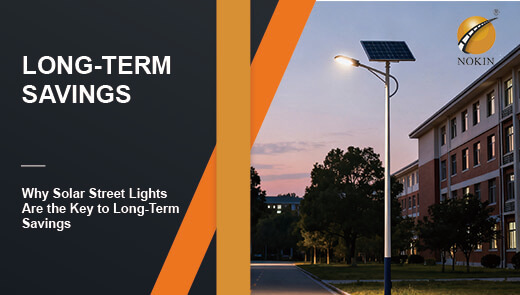Why Switching to LED Street Lights is the Best Investment for Your City
Balancing cost, efficiency and sustainability is always an important issue for city managers when it comes to investment in urban utilities. As technology continues to advance, LED street lights are becoming the ideal choice for urban lighting due to their significant overall advantages.

Energy Efficiency and Cost Savings
Core Principle of Energy Efficiency and Cost Savings
What makes LED street lights stand out in the field of energy saving is their unique working principle. While traditional lighting equipment wastes a large amount of electrical energy as heat, LED street lights convert a higher percentage of electrical energy directly into visible light, greatly reducing energy loss. This efficient mode of energy conversion brings significant improvements to the energy consumption of cities.
Energy Consumption Comparison and Electricity Savings
Compared to traditional lighting technologies such as fluorescent and high pressure sodium lights, LED street lights offer significant energy savings, reducing energy consumption by up to 80%. Taking a traditional 200-watt street light and a 40-watt LED street light as an example, assuming 12 hours of lighting per day, the traditional street light consumes 200×12×365÷1000 = 876 kilowatts of electricity per year, while the LED street light consumes only 40×12×365÷1000 = 175.2 kilowatts. In the case of the same price of electricity, long-term use of LED street lights, the city can save a lot of money on street lights electricity expenses every year.
Long-term Cost Advantages
In addition to the savings in electricity costs brought about by the reduction in energy consumption, the long-life characteristics of LED street lights also bring considerable cost savings to the city. Due to their long lifespan, they can be replaced much less frequently and require less maintenance. This means that cities don't need to invest in manpower and money to replace and repair street lights, saving them a lot of operating costs in the long run.
Longevity and Durability
Extended Lifespan
LED street lights have an impressive lifespan, typically 50,000 to 100,000 hours. Compared to traditional lighting systems, which often need to be replaced every few years, the long life of LED street lights greatly reduces the amount of money and effort cities have to spend on streetlight replacement.
Weather Resistance
LED street lights have excellent environmental adaptability and can operate stably in extreme weather conditions. Whether it is hot, hot, rainy, or windy, LED street lights can maintain reliable illumination. This strong resistance ensures the safety of city roads in all kinds of bad weather and reduces the number of lighting failures caused by weather factors.
Lower Maintenance Costs
LED street lights have significantly lower maintenance costs than traditional street lights because they are replaced less frequently and are less susceptible to damage. Municipal staff do not need to overhaul and replace street lights as often, so they can devote more time and energy to other important municipal work, improving the overall efficiency of municipal work.

LED Street Lights vs. Traditional Street Lights: A Comparison in Lumens and Watts
A Comparison in Lumens and Watts
Lumens and Watts are two key concepts when measuring the lighting efficiency of street lights. Watts measure the energy consumption of a device, while lumens are used to measure the total amount of visible light emitted by a light source and are a more accurate measure of brightness. Generally speaking, traditional high pressure sodium lights produce about 100 lumens of light per watt, while modern LED street lights can produce 130 lumens per watt or more. A comparison is shown below.
|
Street Light Type |
Lumens per Watt |
|
High Pressure Sodium Lamp |
100 |
|
Metal Halide Lamp |
80 - 100 |
|
LED Street Light |
130+ |
Wattage Differences for the Same Light Output
There is a huge difference in the number of watts required to achieve the same level of illumination between an LED streetlight and a conventional streetlight. For example, a 150-watt high-pressure sodium lamp emits only as much luminous flux as a 60-watt LED streetlight. This means that with LED street lights, energy consumption can be significantly reduced while maintaining the same lighting effect.
Advantages of Directional Lighting
Unlike traditional street lights, which emit light in a decentralized manner, LED street lights are designed to emit light in a directional manner. The light emitted by traditional street lights spreads out in all directions, requiring the use of reflectors to guide the light, which leads to a large amount of light waste. LED street lights project light directly onto the area that needs to be illuminated, which greatly improves the efficiency of light utilization and reduces unnecessary light energy loss.
Energy and Protect the Environment
Reduce Carbon Emissions
In the context of global advocacy of energy saving and emission reduction, LED street lights provide strong support for the sustainable development of cities. Due to the significant reduction in energy consumption, cities consume less electricity for street lighting, which in turn reduces carbon emissions from power generation. This is of great significance for cities to realize the goal of green development and enhance the environmental image of the city.

Reducing Hazardous Waste
Traditional street lights often contain mercury and other hazardous substances, which can cause serious pollution to the environment if they are not properly disposed of after the street lights are scrapped. LED street lights do not contain these toxic substances and do not produce hazardous waste after scrapping, which reduces the potential harm to the environment from the source and reduces the pressure on environmental protection for the city.
Enhanced Visibility and Safety
Quality Lighting Enhances Visibility
LED street lights utilize advanced lighting technology to provide clear, even illumination. Under this lighting environment, various details on the road can be clearly presented, both pedestrians and drivers can more clearly observe the surrounding environment, effectively avoiding accidents caused by poor visibility.
The Role of High Color Rendering Index
The color rendering index of LED street lights is close to that of natural sunlight, which can accurately reproduce the true color of objects. This feature is important for color recognition and facial recognition. Under the illumination of LED street lights, drivers can distinguish traffic signals and signs more clearly, and pedestrians can recognize people and objects around them more accurately, thus reducing the probability of accidents, and at the same time playing a positive role in crime prevention.
Challenges in Transitioning to LED Street Lights
Initial Investment
Despite the many advantages of LED street lights, the high initial purchase and installation costs are a real obstacle for some cities. A complete LED street light system, from the procurement of lights to installation and commissioning, is relatively expensive. However, many cities have successfully solved this funding problem by applying for government subsidies and participating in public-private partnership projects.
Retrofitting Existing Infrastructure
Retrofitting existing lighting systems to accommodate LED street lights requires certain technical and resource support. As the working principle and interfaces of LED street lights are different from those of traditional street lights, the retrofitting process requires specialized technicians to design and install the LED street lights, and the power supply system may also need to be adjusted accordingly. Therefore, it is crucial to work with professional industry organizations for adequate planning.

Public Concerns and Resistance
During the process of replacing LED street lights, some residents may have doubts about the new street lights, fearing that the light quality is not as good as that of traditional street lights or that the installation process will be inconvenient. In order to gain public support, city managers need to strengthen communication with the residents by organizing briefing sessions and displaying pilot zones to let them visualize the advantages of LED street lights and allay their concerns.
Future Trends in LED Street Lighting
Photocells
Photocells, as a kind of light-sensitive sensor, are widely used in LED street lights. It can automatically control the switch of street light according to the change of ambient light. When the sky becomes dark, the street light is automatically turned on; when the sky brightens, the street light is automatically turned off. This intelligent control ensures that street lights work only when needed, further improving energy efficiency.
Motion Sensors
Motion Sensors add more intelligence to LED street lights. When the sensor detects people or vehicles passing within a certain range, the street light will automatically light up; when the people or vehicles leave, the street light will automatically dim or turn off. This feature is especially useful in areas with fewer pedestrians and vehicles, meeting lighting needs while maximizing energy savings.
Dimming Capabilities
Modern LED street lights are equipped with intelligent dimming capabilities that automatically adjust the brightness according to the time of day and ambient light conditions. Late at night, when pedestrians and vehicles are scarce, the street light can automatically reduce the brightness; in special weather or during major events, the street light can be increased according to the need for brightness. This flexible dimming mode realizes the fine management of energy while guaranteeing the lighting effect.
Remote Control and Monitoring
With the help of advanced IoT technology, many LED street lights have realized remote control and monitoring functions. City managers can view the working status of each streetlight in real time through the network platform, and remotely adjust the switch and brightness of street lights. Once a streetlight is found to be malfunctioning, the system will issue an alarm in time, and the staff can go to repair it quickly, which greatly improves the efficiency and response speed of streetlight management.
LED street lights have demonstrated unrivaled advantages in terms of energy efficiency, longevity and durability, energy conservation and environmental protection, and improved safety. Although the transition process will face initial investment, infrastructure modification and public acceptance and other challenges, but through reasonable planning and effective solutions, these issues can be properly resolved. In the long run, investing in LED street lights not only saves cities a lot of money, but also pushes them towards green, smart and sustainable development.




